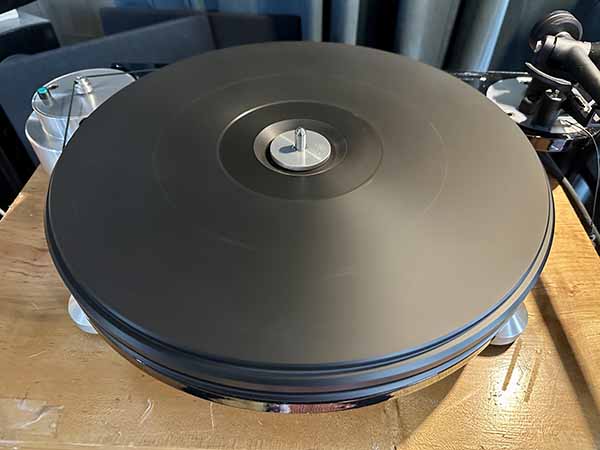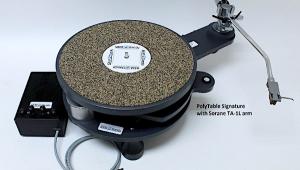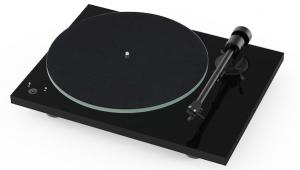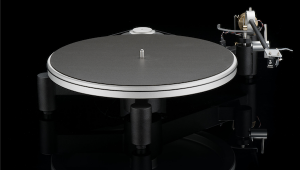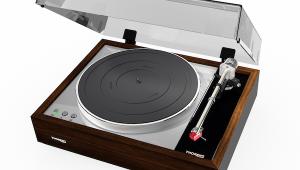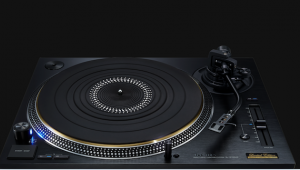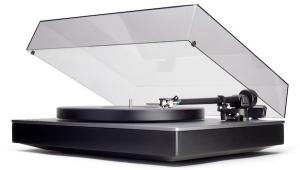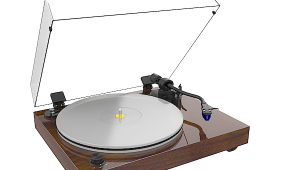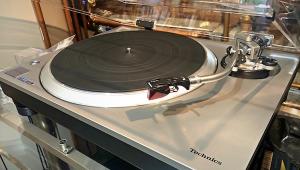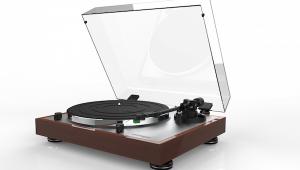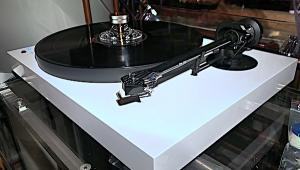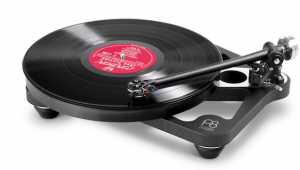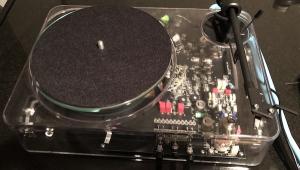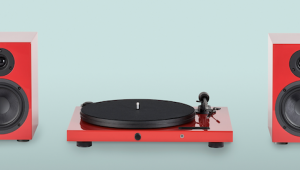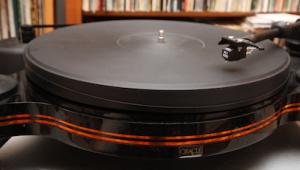Michell TecnoDec Reference Turntable
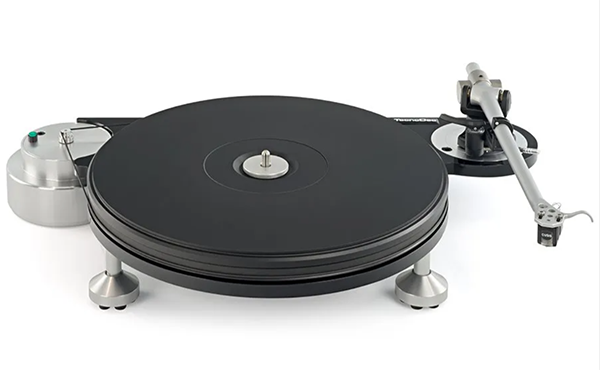
Whenever you’re looking to buy a new turntable, you have to ask yourself a number of questions first, such as the following: How much can I spend on it? How will the turntable fit into my current audio system? What cartridge should I pair with the turntable if it doesn’t include one? Should I go for a belt-drive or a direct-drive design for driving the platter? Should I follow heavy-mass application theories to deaden resonances that can confuse low-level detail, or should I keep things light and agile to achieve the desired levels of PRaT (pace, rhythm, and timing)? Should I go for vintage or new? Should I buy an external phono preamp, or go with a turntable that has one already included?
The first question in that barrage is more likely than not to be the one that carries the most weight with many potential new turntable buyers these days — namely, “How much can I spend on this new vinyl-spinning machinery?” The least expensive, lowest level you can go dollar-wise and still call a machine a turntable is about $249, such as what the U-Turn Orbit Basic turntable currently runs. Naturally, as the SRP level increases, so do improvements in the plinth (base) material and isolation, the platter weight and its material, bearing quality, motor quality, tonearm design and build, tonearm materials, tracking ability, and a long list of adjustments only available with the better tonearms — which, as a result, lead to greater long-term satisfaction and reliability.
Unless it’s something like a ’50s-era Thorens, Empire, Rabco, Garrard, or EMT ’table, I wouldn’t touch vintage turntables myself anymore. Too many things can go wrong and rot away with the purchase of 60-year-old piece of machinery — if you can even find the parts, that is — not to mention being able to secure someone knowledgeable enough to work on the machine if need be. Thus, looking at a new, $1,000-to-$2,000 turntable that’s built to last with modern materials and is generally manufactured to higher spec than less expensive turntables are is the route I prefer to travel these days.
All of that preamble brings us to our review subject today — namely, the British-made Michell TecnoDec Reference turntable, which sports a sweet-spot SRP of $2,698, and comes with an included Michell T3 tonearm. Perhaps best known for their recently revived GyroDec ’table, which was originally a super-hot property in the mid-’80s through the early 2000s, Michell is back in the turntable game, bigtime. (They also offer upper-tier performance with their pricier Orbe and Orbe SE turntables.)
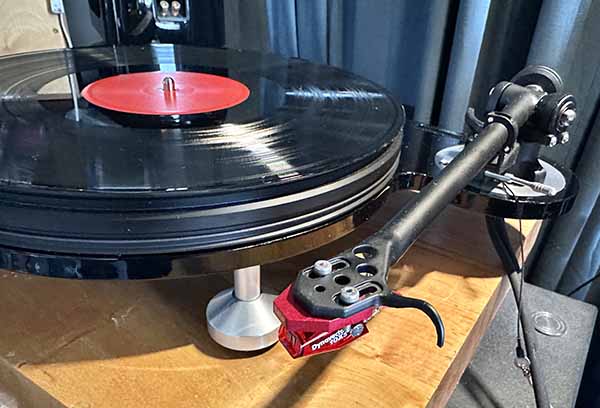
Features & Specs
According to Michell’s site, “The TecnoDec is our entry-level turntable, and it shares many features developed for its bigger brother the GyroDec, such as a vibration dampening, impedance matched platter, inverted oil circulating main bearing, and a free-standing motor unit. The TecnoDec is an unsuspended turntable that utilizes technologies and materials only found in much more expensive turntables, to perform well above its price point.” (We’ll soon enough find out, won’t we?)
The belt-driven TecnoDec ’table includes Sorbothane feet inserts in three pod-like aluminum footers that Michell claims, “isolate the turntable from the supporting surface.” The TecnoDec is a non-suspended table, meaning there’s nothing to cushion the spinning platter from the rest of the table, or the noisy world around it. This in turn pretty much demands an isolation platform to protect the table from footfalls and other exterior noise and vibration.
Also included with the TecnoDec is what they call an “inverted oil-circulating” main bearing. “Contrary to traditional designs,” the Michell site continues, “our main bearing has the point of rotation at the top of the assembly, not at the bottom. This orientation allows us to fully lubricate the inside of the entire bearing while the platter is turning. We achieve this by way of a modified Archimedean screw that we machine into the inside bore of the bearing. The oil is drawn from a reservoir at the base of the main bearing up to the thrust ball at the top, fully lubricating as it goes, it then returns to the reservoir via a waste hole drilled into the bearing spindle. Lubricating the precision parts of the main bearing in this way means that any potential for noise or vibration created by the rotation of the platter is avoided.”
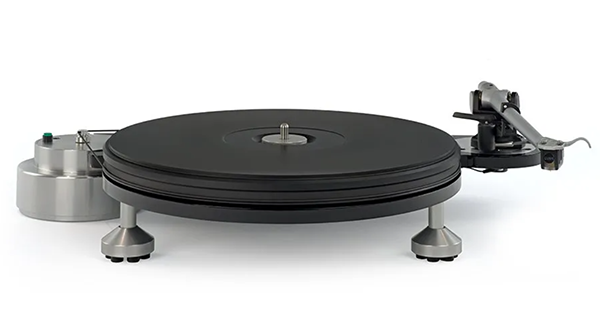
Furthermore, the TecnoDec has something called an “impedance matched” platter made of Delrin, and that its material “was chosen for its vibration dampening characteristics and because sonically it is a very similar material to vinyl, so it has a very neutral sound characteristic.” (That involves impedance?)
The motor is hefty, and it’s machined out of solid aluminum. The TecnoDec’s “free standing” motor unit is “used to drive the turntable [and] is completely separate to the turntable, meaning it doesn’t touch the turntable in any way. The only connection between the motor and the turntable is the drive belt that drives the platter. This stops any noise or vibrations created when the motor is running, getting through to the sensitive parts of the turntable.”
The TecnoDec is sold with the aforementioned Michell T3 tonearm, which is a reworked, modified Rega 330. Oddly, there is no mention of the T3 on the Michell site under their Tonearm section, though I was able to find its individual SRP as being $699. Elsewhere, I gleaned that the machine is terminated with Neutrik RCAs, and 3D CAD & CAM technology was used in its design. A rep at Fidelity Imports further informed me the TecnoDec’s “bearing is grade 10 hardened chromium steel with a brass jacket and an aluminum base/well. The belt is a bespoke polyurethane material. The record spindle is stainless steel.”
I think the super-slim, half-inch TecnoDec plinth is made of some type of plexiglass material — again, I could find nothing about it on the Michell site, and not much in the way of a turntable’s typical specs appeared there either. If you made an unusual-looking, technically stunning turntable with smart engineering, wouldn’t you want to brag more about its constituent parts? That said, I can confirm the weight of the TecnoDec is 4.6kg, and its dimensions are 49 x 8.5 x 31cm (w/h/d).
Good thing there’s an informative TecnoDec turntable unboxing and setup video we can all watch together below.
Setup
I would go through all the salient setup points for the TecnoDec, but the above video pretty much covers it all — and, like they say, a picture says a thousand words (give or take). All in all, I found the TecnoDec to be an easy enough setup — as long as you’re as handy with tools as I am, which I would rate at 4 out of 10. (My using turntable setup tools, that is.)
One oddity among the TecnoDec’s well-packed bits and bobs was its ground wire. Typically, a ground wire is merged with the interconnects, and is of similar length. The TecnoDec ground wire was about 3in long, with a metal loop on its end. (Hmm.) The XLR outputs failed after Day 1, and its RCA outs are branded as phono left and right. The TecnoDec’s chintzy ground cable is indeed of quality material, but it required me to strip some Monster Cable, wrap the bare end around the metal loop, and attach it to the ground screw of my phono preamp. I thought this was really, well, weird — and it’s not mentioned in the setup video either. (Perhaps an homage to the ’50s British way is to ground the tonearm to a screw on the turntable so that when you could be playing records, you’re instead searching for some employable screw on the turntable’s underside. . .?)
At any rate, ancillary components used in this review included a Goldring 1006 moving magnet (MM) cartridge, a new moving coil (MC) cart I’ll name later in the review, Tavish Audio Adagio phono preamp, Parasound Halo Hint 6 integrated amp, and DeVore Fidelity O/baby loudspeakers. Cabling was Triode Wire Labs for the interconnects and Auditorium 23 for the speakers.
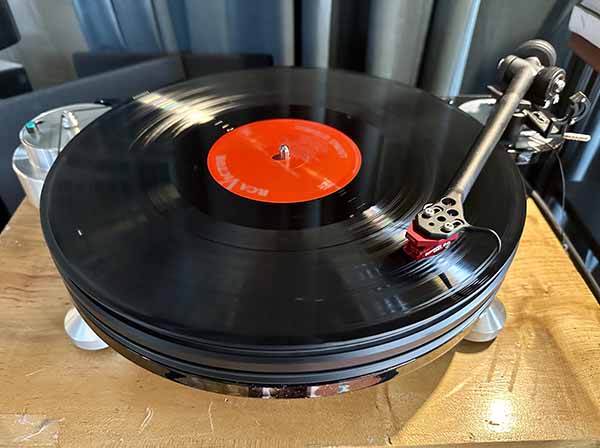
Listening Sessions
Records used during my TecnoDec turntable listening sessions included drum and bass from Photek’s DJ-Kicks (K7 Records !K7293LP); L.A. bassist Billy Mohler’s fine Ultraviolet (Contagious CGM008); newish Craft Recordings reissue of alto saxophonist Art Pepper’s Art Pepper Meets The Rhythm Section (Craft Recordings CR00382); Kraftwerk’s encyclopedic synths, soundstage, and layered bass treatise, Tour De France (Kling Klang 50999 9 66109); and Borodin/Rimsky Korsakov as performed by the London Symphony Orchestra, conducted by Jean Martinon (Classic Records LSC 2298).
Over the past decade, I’ve reviewed a goodly number of turntables. With most of them, there is a period where your ears adjust from the sound of your reference ’table to the new machine’s color, personality, and style — but there was none of that kind of translation period with the TecnoDec. Practically out of the box, and with adequate time using the Goldring 1006 MM cartridge, the TecnoDec took me, my records, and my apartment by almost immediate storm. In fact, I am confident in saying the TecnoDec is one of the finest turntables I’ve ever reviewed. It accomplished perfect synergy with my review system — and that is certainly part of it, but not all of it.
The TecnoDec, when using the dark-sounding Goldring 1006 cart, exhibited superb dynamics, plenty of punch, a wide, spacious, deep soundstage, and tonality that I found to be on the warmish side of neutral. It generally played with speed, precision, and resounding naturalism. Resolution was off the charts, far exceeding what I’d expect from a $2K turntable with a $399 MM cart. While sounding slightly warm and romantic, it was equally transparent and revealing, as heard in small details like the sixteenth-note hi-hats behind the swooping eighth-note hi-hats in Kraftwerk’s Tour De France, or the rugged texture and wide frequency spread of Paul Chambers’ bass on Pepper Meets The Rhythm Section. Detail, resolution, and birds singing at 5,000ft don’t mean squat if your machine doesn’t make music in holistic fashion — and the TecnoDec did just that, record after record.
The TecnoDec achieved the British hi-fi boffins love of the earlier acknowledged PRaT, but not at the expense of depth, warmth, soul, and punch. The sound was distinctive, tight, and to a degree insular, as if the table was mainlining the music straight into my brain. I felt sealed in sound while playing records on the TecnoDec. Every record turned into a performance, gluing me to my seat and having me marvel at what TecnoDec designer John Michell hath wrought.
With Billy Mohler’s Ultraviolet, the sound of his bass extended well beyond the speaker plane — this modern recording sounding super-silent, and super hi-res. With the reissued Art Pepper Craft LP, Philly Joe Jones’ drums were surprisingly resonant, quick, and soulful-sounding — admittedly due in part to the record’s new remastering job — but also via the ability of the TecnoDec and the Goldring cart to make mighty music. With the Photek and Kraftwerk LPs, the TecnoDec played every shade of synth bass between these two records, from the dense, sucking bass sounds of Photek to the impersonal, domineering bass cycles of Kraftwerk. This TecnoDec ’table also exposed the fine organ layering of the Kraftwerk disc.
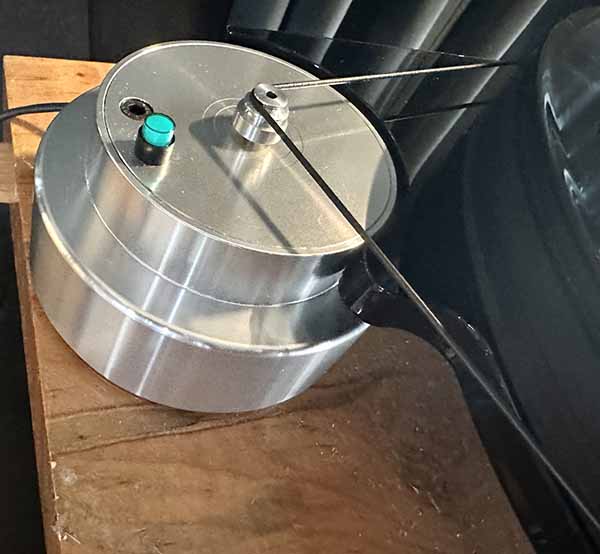
One snag, however. According to the RPM app on my iPhone, the TecnoDec was at first playing slightly fast, so I adjusted it by moving the motor, and the belt, away from the turntable. That corrected the speed, but it also introduced undesirable pitch anomalies, but I was able to work it all out.
I’ve always wanted to hear a Dynavector cartridge in my own system, so I specifically asked Dynavector importer Mike Pranka for one of their carts to use with the TecnoDec. Mike sent along the new Dynavector DV-10X5 MKII Low MC cart (SRP: $800). Its properties include that recognizable red body as well as, quote, “Dynavector Magnetic Flux Damping, Softened Magnetism, and powerful neodymium magnets that provide the smooth treble response Dynavector are renowned for. The Dynavector 10X5 MKII also features an improved stylus assembly with the nude diamond Shibata III line contact stylus, and improved hardened cantilever material. The 10X5 [MKII] now features a powerful neodymium magnet and a recently designed aluminium head block to provide a rigid platform for the cartridge motor and secure fixing to the tonearm.”
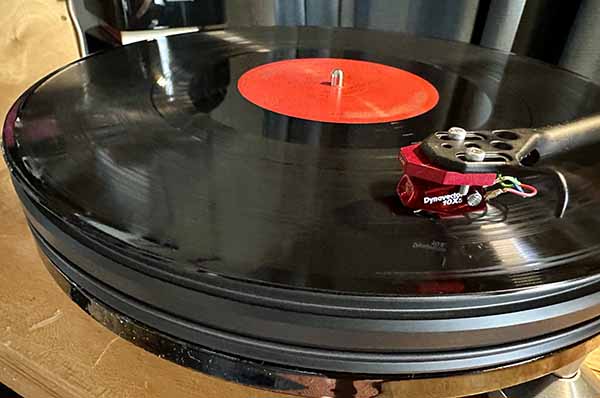
Pins on the Dynavector MC cart were smaller than those of the Goldring MM cart, so a delicate squeezing job was in order. Once dialed in by using my Feickert protractor and Riverstone Audio gauge and setting load impedance on my Tavish Adagio phono preamp, I was off the races. The Dynavector, though not yet up to speed and a little shut-in, provided a more whole, smoother, and tonally sophisticated sound than the Goldring, though the latter cart played with more physicality and energy. Since the Dynavector was not fully broken in, these comparisons are admittedly not totally one-to-one. Transparent to a fault, the TecnoDec still let this new Dynavector MC cart strut its stuff, and I will evaluate it separately in its own review to come at a later date.
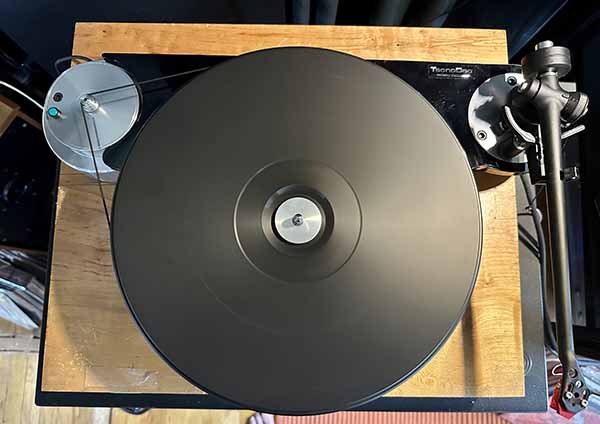
Conclusions
In summation, the Michell TecnoDec is an exceptional turntable, with its clever engineering hid beneath a stylish, industrial look. Though it had some setup peculiarities as noted earlier, when it came to its performance, the TecnoDec sonically wowed me with its dead-silent portrayal of sound — not to mention its physicality, fantastic speed and energy, and its ability to stay calm, cool, and collected no matter how dense and explosive the platter subject matter was (such as was the case with the Borodin/Rimsky Korsakov LP).
Like the GyroDec before it, Michell’s TecnoDec is poised to dominate the $2K to $3K turntable market — and not a moment too soon. (Here’s looking at you, Thorens — perhaps a comparo for another day.) If you’re in the market for a new turntable and you’ve asked yourself all the questions I outlined at the outset of this review, then the stellar-performing Michell TecnoDec just might be the right one for you.
For more about Michell, go here.
To find a Michell distributor near you, go here.
